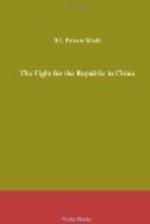The campaign was short and inglorious. The South, ill-furnished with munitions and practically penniless, and always confronted by the same well-trained Northern Divisions who had proved themselves invincible only eighteen months before fought hard for a while, but never became a serious menace to the Central Government owing to the lack of co-operation between the various Rebel forces in the field. The Kiangse troops under General Li Lieh-chun, who numbered at most 20,000 men, fought stiffly, it is true, for a while but were unable to strike with any success and were gradually driven far back from the river into the mountains of Kiangse where their numbers rapidly melted away. The redoubtable revolutionary Huang Hsin, who had proved useful as a propagandist and a bomb-thrower in earlier days, but who was useless in serious warfare, although he assumed command of the Nanking garrison which had revolted to a man, and attempted a march up the Pukow railway in the direction of Tientsin, found his effort break down almost immediately from lack of organization and fled to Japan. The Nanking troops, although deserted by their leader, offered a strenuous resistance to the capture of the southern capital which was finally effected by the old reactionary General Chang Hsun operating in conjunction with General Feng Kuo-chang who had been dispatched from Peking with a picked force. The attack on the Shanghai arsenal which had been quietly occupied by a small Northern Garrison during the months succeeding the great loan transaction, although pushed with vigour by the South, likewise ultimately collapsed through lack of artillery and proper leadership. The navy, which was wholly Southern in its sympathies




